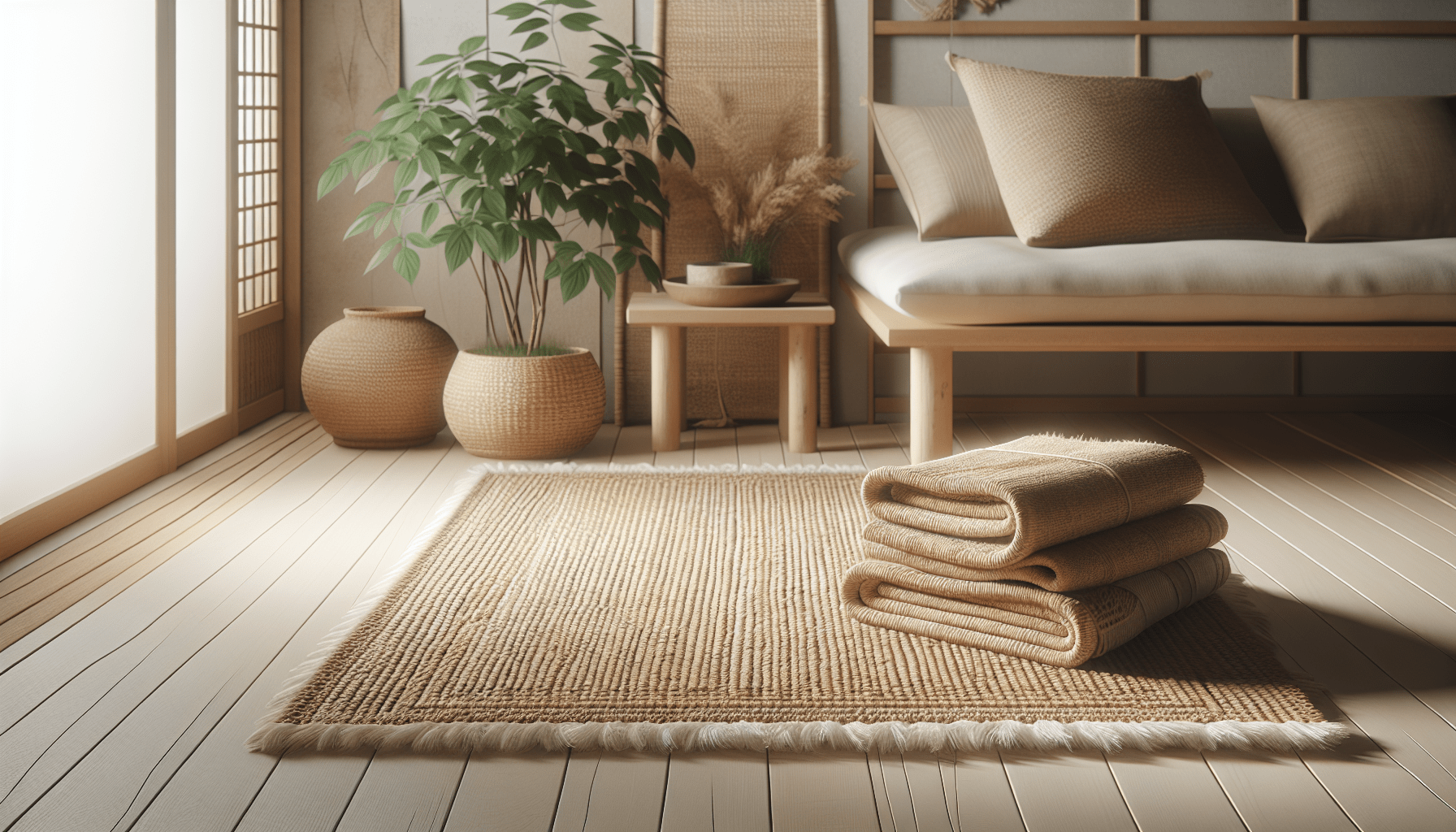How do you incorporate woven textures into a Japandi space? This fascinating question opens the door to a world where minimalism meets coziness, crafting an environment that feels both serene and inviting. In this journey, you’ll learn how to balance the aesthetics of Japanese and Scandinavian designs, using woven textures to enhance the overall vibe. Let’s get into it!
Understanding Japandi Design
Japandi design is a beautiful blend of Japanese and Scandinavian styles. It emphasizes simplicity, functionality, and natural elements. The combination results in a space that feels peaceful yet warm, offering a perfect backdrop for incorporating various textures.
Japanese design is known for its simplicity and attention to detail, valuing craftsmanship and natural materials. On the other hand, Scandinavian design emphasizes functionality and warmth, often using light colors and comfortable furnishings. The fusion of these styles creates a harmonious environment that feels both classy and homey.
Key Characteristics of Japandi Style
- Neutral Color Palette: Earthy tones, soft whites, and muted pastels create a calming atmosphere.
- Natural Materials: Wood, bamboo, and stone are often used to emphasize the beauty of nature.
- Minimalistic Aesthetics: A focus on fewer, well-curated items helps maintain a clear space.
- Functional Furniture: Every piece serves a purpose, blending beauty with utility.
By understanding these key characteristics, you can incorporate woven textures into your Japandi space in a way that enhances the overall design.
The Role of Textures in Interior Design
Textures play a pivotal role in adding depth and interest to any space. They can evoke feelings of warmth and coziness, contrast, and harmony within your interiors. When it comes to Japandi design, carefully selected textures help bridge the simplicity of the style with the comfort that woven elements provide.
Why Woven Textures Work
Woven textures can bring a sense of nature indoors, which is a key principle in Japandi design. They add tactile variety and warmth without overwhelming the senses. Here are a few reasons why woven textures thrive in a Japandi space:
- Natural Aesthetic: Woven materials often come from organic sources, which aligns beautifully with the natural elements emphasized in Japandi design.
- Layering: Textures can create layers within a space, contributing to a warm and inviting atmosphere.
- Contrast: The tactile nature of woven items contrasts against smooth surfaces, which is essential for a balanced visual experience.
Selecting the Right Woven Textures
When choosing woven textures for your Japandi space, it’s crucial to consider the material, color, and overall design. Let’s look at some popular options for incorporating woven elements.
Natural Fiber Rugs
Natural fiber rugs made from materials like jute, sisal, or seagrass provide a solid foundation for your Japandi room. They bring warmth underfoot while adding a casual, earthy element to your decor.
- Jute Rugs: Soft yet durable, making them perfect for high-traffic areas.
- Sisal Rugs: Sturdy with a more coarse texture, great for adding character.
- Seagrass Rugs: Eco-friendly and water-resistant, excellent for kitchens or bathrooms.
Woven Baskets
Baskets add practicality and a bit of flair to your space. They come in various shapes and sizes, serving as storage solutions while enhancing the woven texture theme.
| Type | Use | Aesthetic |
|---|---|---|
| Storage Baskets | Organizing items | Casual, earthy |
| Decorative Baskets | Accent pieces | Bohemian, chic |
Textured Pillows and Throws
Adding woven pillows and throws to your furniture can create a cozy and inviting atmosphere. Look for pieces with intricate patterns or varying weaves to elevate your seating areas.
- Wool Throws: Offer warmth and can be draped over sofas or chairs.
- Linen or Cotton Cushions: Provide comfort while emphasizing natural materials.
Woven Wall Hangings
Wall art is another great way to introduce woven textures into your space. Tapestries, macramé, or woven wall decor can serve as stunning focal points.
- Macramé Wall Hangings: Add bohemian flair while remaining understated.
- Woven Tapestries: Create a soft visual backdrop, adding warmth to stark walls.
Incorporating Woven Textures into Your Japandi Space
Now that you understand the importance of woven textures in Japandi design, let’s explore various ways to incorporate them seamlessly into your space.
Layering Textures
Layering textures creates depth and visual interest. Start by incorporating a natural fiber rug under your furniture. Add cushions and throws on top for a cozy look. This approach invites comfort and warmth, making your space feel more welcoming.
- Choose a base rug with a simple design.
- Add contrasting textures through woven baskets for storage.
- Finally, layer with cushions and throws to encourage relaxation.
Creating Focal Points
Utilize woven textures to create focal points in your space. A large tapestry or woven wall hanging can serve as the centerpiece of your living room. Pair it with minimalist furniture to ensure the woven piece stands out.
- Opt for a bold, textured wall hanging.
- Position it above a sleek console or sofa.
- Keep surrounding decor simple to let it shine.
Balancing Colors and Patterns
In a Japandi space, it’s essential to maintain a balance between colors and patterns. Woven textures can add visual interest without overwhelming the space. Stick to a neutral color palette with occasional earthy tones.
- Select woven pieces in complementary shades to your space.
- Mix textures without clashing patterns to maintain harmony.
- Use woven items to add subtle pops of interest.
Incorporating Plants
Plants naturally complement woven textures due to their organic shapes and colors. Use woven planters or baskets to house your indoor greenery, enhancing both the natural aesthetic and texture.
- Choose planters made from sustainable materials like rattan or jute.
- Place them in groups for a lush, inviting arrangement.
- Opt for a variety of plant sizes to create depth.
Practical Tips for Using Woven Textures
Integrating woven textiles isn’t just about aesthetics; practicality should also be a concern. Here are some tips to keep in mind.
Pay Attention to Maintenance
Woven textiles may require specific care, depending on the material. Natural fibers can be more sensitive to stains or moisture. Ensure you follow care instructions to maintain their appearance.
- Vacuum regularly to remove dust.
- Spot clean with mild detergent when necessary.
- Avoid placing woven rugs in overly damp areas.
Choose Quality Over Quantity
When it comes to woven textures, quality matters more than quantity. Investing in a few high-quality pieces can elevate the space without cluttering it. Look for handmade or artisan-made items that reflect the careful craftsmanship at the heart of Japandi design.
Layer Wisely
While layering textures can add depth, be mindful not to overdo it. Too many woven elements can lead to a chaotic look. Strive for balance by keeping other design elements minimal.
- Limit your woven textures to one or two on any given piece of furniture.
- Use colors and styles that complement one another.
- Ensure there’s enough space for each texture to be appreciated.
Final Thoughts
Incorporating woven textures into your Japandi space invites a warm, inviting atmosphere while honoring the principles of simplicity and functionality. By paying attention to the textures you choose and how you layer them, you can create a harmonious environment that is both stylish and cozy. As you implement these ideas, remember to enjoy the creative process; your space should reflect your personality and comfort. Enjoy the journey of crafting your perfect Japandi sanctuary!

